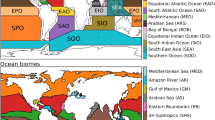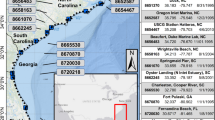Abstract
The quality of simulation of model fields is analyzed depending on the assimilation of various types of data using the PDAF software product assimilating synthetic data into the NEMO global ocean model. Several numerical experiments are performed to simulate the ocean–sea ice system. Initially, free model was run with different values of the coefficients of horizontal turbulent viscosity and diffusion, but with the same atmospheric forcing. The model output obtained with higher values of these coefficients was used to determine the first guess fields in subsequent experiments with data assimilation, while the model results with lower values of the coefficients were assumed to be true states, and a part of these results was used as synthetic observations. The results are analyzed that are assimilation of various types of observational data using the Kalman filter included through the PDAF to the NEMO model with real bottom topography. It is shown that a degree of improving model fields in the process of data assimilation is highly dependent on the structure of data at the input of the assimilation procedure.




Similar content being viewed by others
REFERENCES
I. O. Dumanskaya, A. A. Zelenko, S. A. Myslenkov, E. S. Nesterov, S. K. Popov, Yu. D. Resnyanskii, and B. S. Strukov, “Marine Hydrological Forecasting and Operational Oceanology in the Hydrometeorological Center of Russia,” Gidrometeorologicheskie Issledovaniya i Prognozy, No. 4 (2019) [in Russian].
A. A. Zelenko and Yu. D. Resnyanskii, “Marine Observational Systems as an Integral Part of Operational Oceanology: A Review,” Meteorol. Gidrol., No. 12 (2018) [Russ. Meteorol. Hydrol., No. 12,43 (2018)].
M. N. Kaurkin, R. A. Ibrayev, and K. P. Belyaev, “Data Assimilation in the Ocean Circulation Model of High Spatial Resolution Using the Methods of Parallel Programming,” Meteorol. Gidrol., No. 7 (2016) [Russ. Meteorol. Hydrol., No. 7, 41 (2016)].
A. N. Kolmogorov, “Equations of Turbulent Motion of Incompressible Fluid,” Izv. AN SSSR, Ser. Fiz., No. 1–2, 6 (1942) [in Russian].
G. K. Korotaev, “Operational Oceanography: A New Branch of Modern Oceanology,” Vestnik Rossiiskoi Akademii Nauk, No. 7, 88(2018) [in Russian].
G. I. Marchuk, B. E. Paton, G. K. Korotaev, and V. B. Zalesny, “Data-Computing Technologies: A New Stage in the Development of Operational Oceanography,” Izv. Akad. Nauk, Fiz. Atmos. Okeana, No. 6, 49 (2013) [Izv., Atmos. Oceanic Phys., No. 6, 49 (2013)].
G. A. Sarkisyan and V. N. Stepanov, “Method for Calculating Physical Characteristics of the Ocean from an Individual Hydrologic Section,” Izv. Akad. Nauk, Fiz. Atmos. Okeana, No. 4, 35(1999) [Izv., Atmos. Oceanic Phys., No. 4, 35 (1999)].
V. N. Stepanov, Yu. D. Resnyanskii, B. S. Strukov, and A. A. Zelenko, “Large-scale Ocean Circulation and Sea Ice Characteristics Derived from Numerical Experiments with the NEMO Model,” Meteorol. Gidrol., No. 1 (2019) [Russ. Meteorol. Hydrol., No. 1, 44 (2019)].
B. S. Strukov, Yu. D. Resnyanskii, and A. A. Zelenko, “Relaxation Method for Assimilation of Sea Ice Concentration Data in the NEMO–LIM3 Multicategory Sea Ice Model,” Meteorol. Gidrol., No. 2 (2020) [Russ. Meteorol. Hydrol., No. 2, 45 (2020)].
A. Androsov, L. Nerger, R. Schnur, J. Schroter, A. Albertella, R. Rummel, R. Savcenko, W. Bosch, S. Skachko, and S. Danilov, “On the Assimilation of Absolute Geodetic Dynamic Topography in a Global Ocean Model: Impact on the Deep Ocean State,” J. Geodesy, 93 (2019).
R. Dussin, B. Barnier, L. Brodeau, and J.-M. Molines, The Making of the DRAKKAR Forcing Set DFS5, DRAKKAR/MyOcean Report 01-04-16, April 2016, https://www.drakkarocean.eu/publications/reports/report_DFS5v3_April2016.pdf.
G. Gaspari and S. E. Cohn, “Construction of Correlation Functions in Two and Three Dimensions,” Quart. J. Roy. Meteorol. Soc., 125 (1999).
P. R. Gent and J. C. Mcwilliams, “Isopycnal Mixing in Ocean Circulation Models,” J. Phys. Oceanogr., No. 1, 20 (1990).
P. L. Houtekamer and H. L. Mitchell, “A Sequential Ensemble Kalman Filter for Atmospheric Data Assimilation,” Mon. Wea. Rev., 129 (2001).
P. L. Houtekamer and H. L. Mitchell, “Data Assimilation Using an Ensemble Kalman Filter Technique,” Mon. Wea. Rev., 126(1998).
B. R. Hunt, E. J. Kostelich, and I. Szunyogh, “Efficient Data Assimilation for Spatiotemporal Chaos: A Local Ensemble Transform Kalman Filter,” Physica D, 230 (2007).
P. Kirchgessner, J. Todter, B. Ahrens, and L. Nerger, “The Smoother Extension of the Nonlinear Ensemble Transform Filter,” Tellus A, 69 (2017).
W. G. Large and S. G. Yeager, Diurnal to Decadal Global Forcing for Ocean and Sea Ice Models: The Data Sets and Flux Climatologies, Technical Report TN-460+STR (NCAR, 2004).
R. A. Locarnini, A. V. Mishonov, J. I. Antonov, T. P. Boyer, H. E. Garcia, O. K. Baranova, M. M. Zweng, C. R. Paver, J. R. Reagan, D. R. Johnson, M. Hamilton, and D. Seidov, World Ocean Atlas 2013, Vol. 1: Temperature, Ed. by S. Levitus (NOAA Atlas NESDIS 73, 2013).
G. Madec and the NEMO team, Nemo Ocean Engine—Version 3.6, Technical Report No. 27 (Pole de Modelisation de l’Institut Pierre Simon Laplace, 2016).
L. Nerger and W. Hille, “Software for Ensemble-based Data Assimilation Systems—Implementation Strategies and Scalability,” Computers and Geosciences, 55 (2013).
L. Nerger, W. Hiller, and J. Schroter, “PDAF—The Parallel Data Assimilation Framework: Experience with Kalman Filtering,” inUse of High Performance Computing in Meteorology(2005).
D. T. Pham, J. Verron, and M. C. Roubaud, “A Singular Evolutive Extended Kalman Filter for Data Assimilation in Oceanography,” J. Mar. Syst., 16 (1998).
Sea Ice Modelling Integrated Initiative (SI3)—The NEMO Sea Ice Engine, Scientific Notes of Climate Modelling Center, No. 31 (Institut Pierre-Simon Laplace).
J. Todter, P. Kirchgessner, L. Nerger, and B. Ahrens, “Assessment of a Nonlinear Ensemble Transform Filter for High-dimensional Data Assimilation,” Mon. Wea. Rev., 144 (2016).
M. Vancoppenollea, T. Fichefet, H. Goosse, S. Bouillon, G. Madec, and M. A. M. Maqueda, “Simulating the Mass Balance and Salinity of Arctic and Antarctic Sea Ice. 1. Model Description and Validation,” Ocean Modelling, No. 1–2, 27 (2009).
M. M. Zweng, J. R. Reagan, J. I. Antonov, R. A. Locarnini, A. V. Mishonov, T. P. Boyer, H. E. Garcia, O. K. Baranova, D. R. Johnson, D. Seidov, and M. M. Biddle, World Ocean Atlas 2013, Vol. 2: Salinity, Ed. by S. Levitus (NOAA Atlas NESDIS 74, 2013).
Author information
Authors and Affiliations
Corresponding author
Additional information
Translated from Meteorologiya i Gidrologiya, 2021, No. 2, pp. 50-66. https://doi.org/10.52002/0130-2906-2021-2-50-66.
About this article
Cite this article
Stepanov, V.N., Resnyanskii, Y.D., Strukov, B.S. et al. Evaluating Effects of Observational Data Assimilation in General Ocean Circulation Model by Ensemble Kalman Filtering: Numerical Experiments with Synthetic Observations. Russ. Meteorol. Hydrol. 46, 94–105 (2021). https://doi.org/10.3103/S1068373921020047
Received:
Published:
Issue Date:
DOI: https://doi.org/10.3103/S1068373921020047




